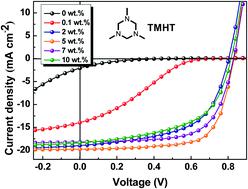当前位置:
X-MOL 学术
›
Sustain. Energy Fuels
›
论文详情
Our official English website, www.x-mol.net, welcomes your
feedback! (Note: you will need to create a separate account there.)
N-doping of fullerene using 1,3,5-trimethylhexahydro-1,3,5-triazine as an electron transport layer for nonfullerene organic solar cells
Sustainable Energy & Fuels ( IF 5.0 ) Pub Date : 2020-01-27 , DOI: 10.1039/c9se01015g Jing Li 1, 2, 3, 4 , Fei Qin 1, 2, 3, 4 , Wenwu Zeng 1, 2, 3, 4 , Lulu Sun 1, 2, 3, 4 , Wen Wang 1, 2, 3, 4 , Yinhua Zhou 1, 2, 3, 4
Sustainable Energy & Fuels ( IF 5.0 ) Pub Date : 2020-01-27 , DOI: 10.1039/c9se01015g Jing Li 1, 2, 3, 4 , Fei Qin 1, 2, 3, 4 , Wenwu Zeng 1, 2, 3, 4 , Lulu Sun 1, 2, 3, 4 , Wen Wang 1, 2, 3, 4 , Yinhua Zhou 1, 2, 3, 4
Affiliation

|
Electron-collecting interfacial layers play an important role in nonfullerene (NF) organic solar cells (OSCs). ZnO and polyethylenimine ethoxylated (PEIE) are the generally used interfacial materials in inverted NF OSCs. However, NF OSCs tend to show poor chemical and photostability in the presence of the two materials. Here, we demonstrate another option that doped fullerene with an n-dopant of 1,3,5-trimethylhexahydro-1,3,5-triazine (TMHT) can be an efficient electron-transport layer (ETL) for efficient NF solar cells. The TMHT doping improves conductivity by three orders of magnitude and shifts the Fermi levels of PCBM by 0.3 eV. As the doping concentration increases, the electron collection properties of the doped layer were significantly enhanced as confirmed by the current density–voltage (J–V) characteristics of the devices. S-kinks in the J–V characteristics gradually disappear and the fill factor increases from 0.13 to 0.69. The devices with a doped PCBM ETL show better photostability under continuous illumination compared with reference devices with a ZnO ETL.
中文翻译:

使用1,3,5-三甲基六氢-1,3,5-三嗪作为非富勒烯有机太阳能电池的电子传输层对富勒烯进行N掺杂
电子收集界面层在非富勒烯(NF)有机太阳能电池(OSC)中起着重要作用。ZnO和聚乙烯亚胺乙氧基化(PEIE)是倒置NF OSC中常用的界面材料。但是,NF OSC在两种材料存在下往往显示出较差的化学和光稳定性。在这里,我们证明了另一种选择,即用1,3,5-三甲基六氢-1,3,5-三嗪(TMHT)的正掺杂剂掺杂富勒烯可以是有效NF太阳能电池的有效电子传输层(ETL)。TMHT掺杂将导电率提高了三个数量级,并使PCBM的费米能级移动了0.3 eV。随着掺杂浓度的增加,通过电流密度-电压(J –V)设备的特性。J - V特性中的S扭结逐渐消失,填充系数从0.13增加到0.69。与具有ZnO ETL的参考器件相比,具有PCBM ETL掺杂的器件在连续照明下显示出更好的光稳定性。
更新日期:2020-01-27
中文翻译:

使用1,3,5-三甲基六氢-1,3,5-三嗪作为非富勒烯有机太阳能电池的电子传输层对富勒烯进行N掺杂
电子收集界面层在非富勒烯(NF)有机太阳能电池(OSC)中起着重要作用。ZnO和聚乙烯亚胺乙氧基化(PEIE)是倒置NF OSC中常用的界面材料。但是,NF OSC在两种材料存在下往往显示出较差的化学和光稳定性。在这里,我们证明了另一种选择,即用1,3,5-三甲基六氢-1,3,5-三嗪(TMHT)的正掺杂剂掺杂富勒烯可以是有效NF太阳能电池的有效电子传输层(ETL)。TMHT掺杂将导电率提高了三个数量级,并使PCBM的费米能级移动了0.3 eV。随着掺杂浓度的增加,通过电流密度-电压(J –V)设备的特性。J - V特性中的S扭结逐渐消失,填充系数从0.13增加到0.69。与具有ZnO ETL的参考器件相比,具有PCBM ETL掺杂的器件在连续照明下显示出更好的光稳定性。











































 京公网安备 11010802027423号
京公网安备 11010802027423号